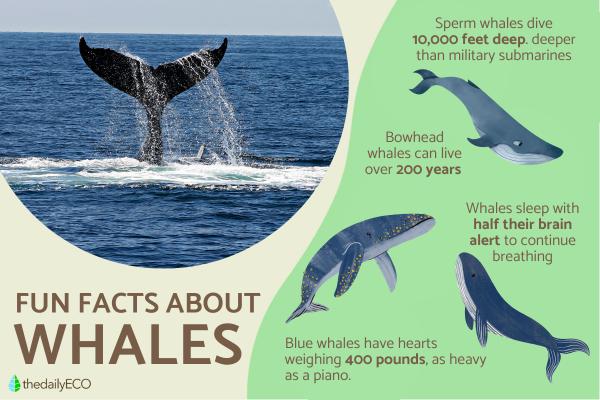
Whales belong to the order of cetaceans and are among the most studied marine mammals on our planet. They stand out for their size, adaptability to ocean life, distinctive songs, and unique respiratory system that requires surfacing for oxygen. These massive animals are full of surprises.
This article by thedailyECO explores key whale facts to help you understand what makes these marine mammals so especial.
They're mammals, not fish
Despite living in oceans and having streamlined bodies like fish, whales are mammals. They breathe air, maintain warm body temperature, give birth to live young, and nurse their calves with milk. Unlike fish with gills, whales must surface to breathe through their blowhole.
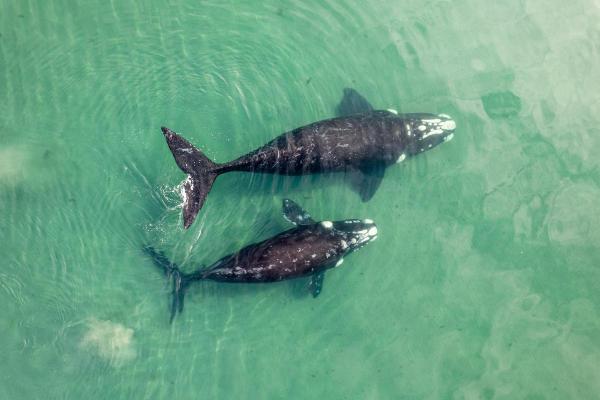
They sing complex songs
Humpback whales produce songs that last up to 20 minutes and travel long distances underwater. Males primarily use these songs for communication and courtship. Each humpback population develops its own unique song that evolves over time. Marine biologists track these changes to study population movements and behavior patterns.
Ever wondered how a peculiar whale digestive product became one of the most sought-after ingredients in high-end perfumery? Explore the story in our other article.
They can live over 200 years
The bowhead whale ranks among the longest-living animals on Earth, with lifespans exceeding 200 years. Their longevity stems from a combination of genetic factors and slow metabolism. Researchers have found specimens with 19th-century harpoons embedded in their skin, confirming their exceptional lifespan and making them the oldest known mammals.
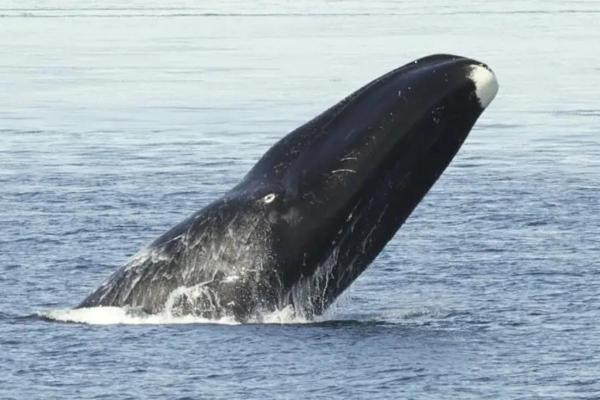
They're the largest animals ever
Blue whales hold the title of largest animals ever to exist, surpassing even the biggest dinosaurs. They reach lengths of 100 feet and weights over 200 tons. A blue whale's tongue weighs as much as an elephant, and its heart matches the size of a small car. Despite this enormous size, they feed almost exclusively on krill, which are tiny crustaceans filtered through their baleen plates.
They sleep with half their brain
Whales can't sleep like humans because they need to surface regularly for air. They've evolved unihemispheric sleep, where only half their brain rests while the other half stays alert for breathing and predators. Sperm whales often sleep vertically, floating head-up in a semi-conscious state. This adaptation balances their need for rest with survival requirements. Dive deeper into the complete science behind whale sleep in our other article.
They migrate thousands of miles
Gray whales undertake some of the longest migrations of any mammal. They travel approximately 12,000 miles annually between Arctic feeding grounds and Mexican breeding waters. This migration plays a fundamental role in their reproductive cycle and survival strategy. Scientists track these movements to monitor population health and ocean conditions.
They have complex social lives
Whales have complex brains and demonstrate advanced behaviors including tool use, teaching, and group cooperation. Many species form organized social units, particularly orcas, whose family pods stay together for life. Their social bonds rival those of elephants and primates.
They hunt with bubble nets
Humpback whales use a cooperative hunting technique called bubble netting. They swim in circles while exhaling bubbles to create a barrier that concentrates fish. This coordinated strategy demonstrates their problem-solving abilities and social cooperation. The technique passes from generation to generation through social learning.
Curious about the Arctic's most iconic whale species? Our other article explores the extraordinary adaptations of the spiraled-tusk whale and its vocal, snow-white cousin that navigate life in frigid northern seas.
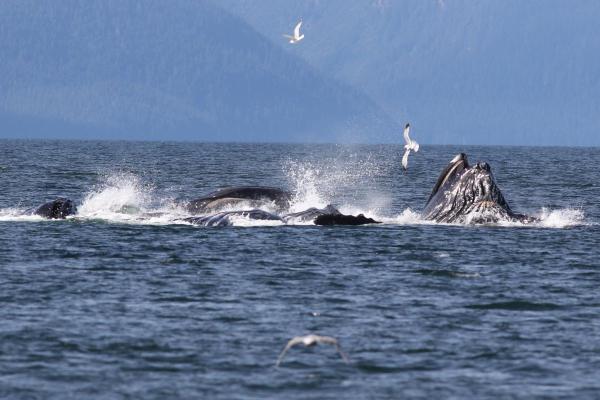
They have car-sized hearts
The blue whale's heart is the largest of any animal and weighs about 400 pounds (180 kg). Its heartbeat can be detected from over 2 miles away underwater. When diving deep, a blue whale's heart slows to just 8-10 beats per minute to conserve oxygen. This adaptation helps them stay submerged longer while hunting for food. To put this size in perspective, the blue whale's heart is approximately the size of a small car and pumps 60 gallons of blood with each beat.
They talk using infrasound
Blue and fin whales produce low-frequency sounds that travel hundreds of miles through ocean water. These infrasound communications fall below human hearing range but allow whales to coordinate across vast distances. The sound travels efficiently through water, creating ocean-wide communication networks.
They don't all have teeth
Whales divide into two main groups:
- Odontocetes (toothed whales)
- Mysticetes (baleen whales).
Baleen whales like blues and humpbacks use bristle-like plates to filter small prey from water. Toothed whales, including orcas and sperm whales, hunt larger prey like fish and squid. This evolutionary split allowed whales to occupy different feeding niches in ocean ecosystems.
From the massive filtering plates of the blue whale to the specialized hunting teeth of the orca, discover how whale mouths have evolved for different feeding strategies in our related article.
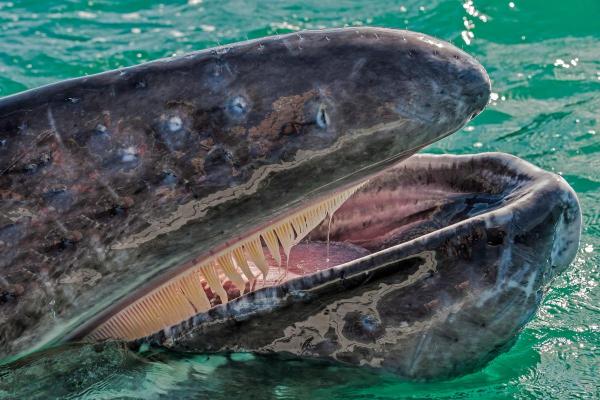
They dive deeper than any mammal
Sperm whales are the mammal with the greatest diving capacity. They can dive to depths of up to 10,000 feet (3,000 meters) in search of giant squid, their main food source. To achieve this remarkable feat, they reduce their heart rate to just three beats per minute, redistributing oxygen to vital organs and allowing their body to withstand the immense pressure of the ocean depths. Sperm whales can remain underwater for up to 90 minutes before needing to surface for air, making them true champions of the deep ocean.
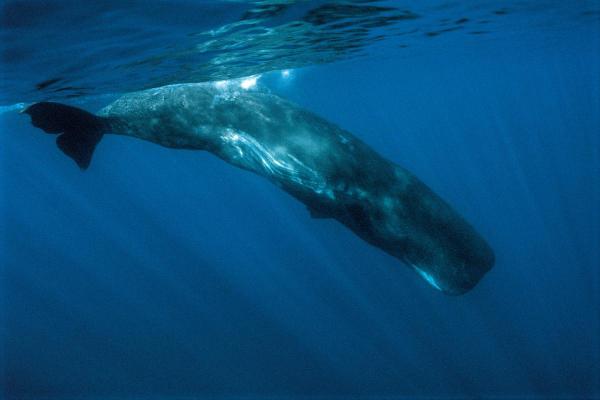
They are related to hippos
The closest living relatives of whales aren't other marine creatures but hippopotamuses. About 50 million years ago, whale ancestors were hoofed land mammals that gradually adapted to aquatic life. Their front legs evolved into flippers while their hind legs disappeared. This transition from land to sea represents one of evolution's most dramatic transformations.
They use sound to see
Toothed whales navigate and hunt using echolocation. They emit sounds that bounce off objects, creating detailed acoustic maps of their surroundings. This natural sonar system works with such precision that whales can detect the size, shape, and density of objects in complete darkness. Some species distinguish between different fish types based solely on echo patterns.
Curious about the biological sonar that helps whales navigate underwater? Dive deeper into the fascinating acoustic sensing ability that allows certain species to create detailed 'sound pictures' of their environment
They help fight climate change
Whales serve as critical components in ocean carbon cycling. When they die naturally, their carcasses sink to the seafloor, sequestering tons of carbon for centuries. Their feeding and waste also fertilize the oceans, stimulating phytoplankton growth that absorbs atmospheric CO₂. Research indicates healthy whale populations contribute significantly to ocean productivity and climate regulation.
If you want to read similar articles to Fun Facts About Whales, we recommend you visit our Facts about animals category.
- Berta, A., Sumich, J. L., & Kovacs, K. M. (2015). Marine mammals: Evolutionary biology (3rd ed.). Academic Press. https://www.elsevier.com/books/marine-mammals/berta/978-0-12-397002-2
- Goldbogen, J. A., Cade, D. E., Calambokidis, J., Friedlaender, A. S., Potvin, J., Segre, P. S., & Werth, A. J. (2017). How baleen whales feed: The biomechanics of engulfment and filtration. Annual Review of Marine Science, 9, 367-386. https://doi.org/10.1146/annurev-marine-122414-033905
- Keane, M., Semeiks, J., Webb, A. E., Li, Y. I., Quesada, V., Craig, T., Madsen, L. B., van Dam, S., Brawand, D., Marques, P. I., Michalak, P., Kang, L., Bhak, J., Yim, H. S., Grishin, N. V., Nielsen, N. H., Heide-Jørgensen, M. P., Oziolor, E. M., Matson, C. W., ... de Magalhães, J. P. (2015). Insights into the evolution of longevity from the bowhead whale genome. Cell Reports, 10(1), 112-122. https://doi.org/10.1016/j.celrep.2014.12.008
- National Oceanic and Atmospheric Administration. (2023). Sperm whale. NOAA Fisheries. https://www.fisheries.noaa.gov/species/sperm-whale
- National Oceanic and Atmospheric Administration. (2023). The big-hearted blue whale. NOAA Fisheries. https://www.fisheries.noaa.gov/feature-story/big-hearted-blue-whale